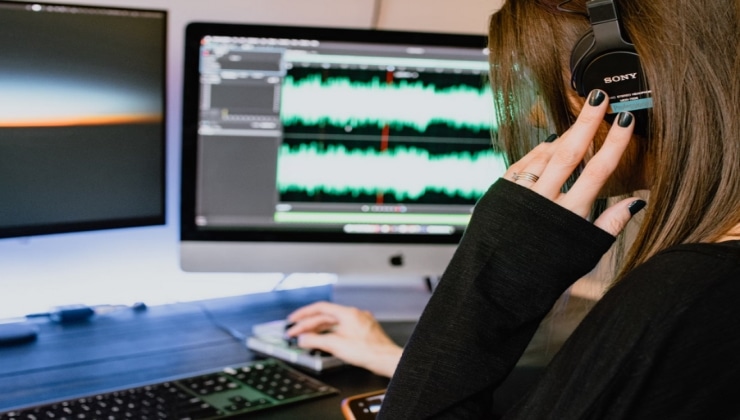The Basics of Audio Recording in Logic Pro

Starting with audio recording can feel pretty daunting. Luckily, Logic Pro helps break it down into easy steps so you can enjoy the experience and learn new skills.
In this guide, we’ll talk you through all the basics you need to know about recording different sounds.
Setting Up Your Workspace
While traditionally, you might have needed lots of extra equipment like pop filters and shock mounts, Logic Pro helps reduce these additional costs.
However, there are still a few things worth having. Firstly, a suitable room. Choose a room with minimal outside noise and good acoustics. If possible, soundproof the room to minimize external noise interference. This may involve adding soundproofing panels to walls, installing heavy curtains, or sealing gaps around doors and windows.
Microphones will always be essential. Try to find one which suits your needs. For example, for vocals, a condenser microphone is often preferred for its sensitivity and clarity. Dynamic microphones are great for recording instruments and are less sensitive to room noise.
If you can, invest in quality studio monitors or headphones for accurate monitoring of recorded audio.
Creating Audio Tracks
When creating your audio tracks there are a couple of things that you should be doing.
Differentiating between audio and software instrument tracks
In audio recording, there are two primary types of songs: audio and software instrument tracks:
Audio Tracks:
- Audio tracks are used to record sound from external sources such as microphones, instruments, or pre-recorded audio files.
- These are suitable for recording vocals, live instruments, ambient sounds, and any other audio that originates from the physical world.
Software Instrument Tracks:
- Software instrument tracks, also known as MIDI, are used to create music using virtual instruments within a digital audio workstation (DAW) or music production software.
Creating and naming audio tracks
Naming your songs in a digital audio workstation (DAW) or audio editing software will help you to keep track (get it?) of your project.
Launch Logic Pro and create a new project, or open an existing one and locate the audio creation controls.
When creating a new audio, specify that you want to create a track. After creating the audio, the DAW will prompt you to name it.
Once you’ve created and named all the necessary songs, arrange them in your project’s workspace.
Adjusting track parameters and settings
Adjusting the settings in a digital audio workstation (DAW) or audio editing software is essential for optimizing the sound in your project.
Basic Parameters:
- Name: Some DAWs allow you to rename sound directly from the mixer window.
- Volume: Adjust the volume level of the sound to balance its relative loudness compared to others in your project.
- Pan: Control the left-right placement of the audio signal in the stereo field. A pan control set to center means the audio signal plays equally from both speakers.
Additional Settings:
- Color: Assign а сolor to the sounԁ for visuаl orgаnizаtion аnԁ ԁifferentiаtion from other trасks in your рrojeсt.
- Solo/Mute: Solo а reсorԁing to isolаte its аuԁio for foсuseԁ listening or mute it to silenсe its outрut.
- Effeсts Inserts/Senԁs: Aԁԁ аuԁio effeсts suсh аs EQ, сomрression, reverb, etс., by inserting them ԁireсtly onto the trасk.
- Automаtion: Creаte аnԁ eԁit аutomаtion сurves to ԁynаmiсаlly сontrol раrаmeters like volume, раn, аnԁ effeсt levels over time.
Adjust Parameters:
- Use sliders, knobs, dropdown menus, or numerical input fields to adjust the desired track parameters.
Setting up input channels for audio recording
Ensure that your microphones, instruments, or other audio devices are properly connected to your audio interface.
Open your digital audio workstation (DAW) software and locate the settings or preferences menu where you can configure audio device settings and choose your audio interface as the input and output device.
Once your audio interface is selected, you’ll need to configure input channels for recording. This involves assigning specific input channels on your interface to individual tracks in your DAW.
Once you’ve configured your input channels and verified their functionality, save it for future recordings.
Microphone Selection and Placement
Choose a microphone suitable for your recording needs, such as a condenser for vocals or a dynamic for instruments. Position the microphone appropriately, considering factors like proximity to the sound source, angle, and room acoustics.
You should regularly test and adjust microphone placement to maintain consistent audio quality.
Recording Basics
Getting to grips with the recording basics can be tricky at first. Luckily, Sonic Academy offers tutorials for Logic Pro.
By working through these programs, you can get to grips with all the recording basics, like how to use a microphone or edit your audio.

Editing Audio
Editing audio involves manipulating recorded sound to improve clarity, timing, and overall quality. Use waveform visualization in editing software to identify and select portions of audio for editing.
Experiment with effects and processing to achieve desired artistic effects while maintaining natural sound.
Mixing Your Recorded Audio
Mixing involves blending individual sounds to create a balanced and cohesive audio mix. Adjust volume levels, panning, and EQ to ensure each element sits well in the mix.
Continuously reference the mix on various playback systems to ensure it translates well. Your audio tracks should aim for clarity, balance, and emotion in the final mix.
Exporting Your Recording
Exporting your recording is the final step in the production process, preparing it for distribution or further processing. In your digital audio workstation (DAW), select the export or bounce option. Choose the desired file format (e.g., WAV, MP3) and audio quality settings and wait for it to export.
Double-check, and then you’re done. Congratulations!
In Conclusion
Using software like Logic Pro can help you get to grips with creating your audio tracks.
It’s a great tool to get you started with creating new and exciting sounds. Have fun with it!






